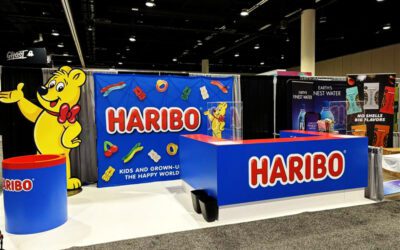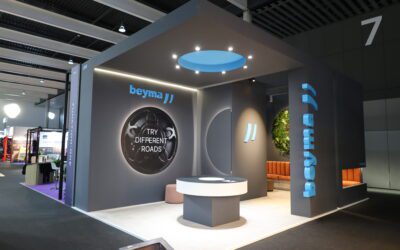How do you start a conversation that will pull a visitor into your exhibit? For every person working the booth at a trade show, that question is top of mind at all times.
Could humor be the key to making a connection? In this blog, Jay talks with Jon Selig, founder of Comedy Writing for Revenue Teams, about how humor can be used to break the ice.
Finding Funny in an Unlikely Place
Selig began his career at Oracle, where he sold enterprise software applications. From there, he worked in a similar role with an Oracle partner. And throughout his sales experience, he discovered something unexpected.
“I had watched a lot of my sales engineers run through demo scripts, and they had jokes they dropped in that made powerful points about the problems they’re solving for their customers,” Jon says. “The customers really appreciated it because they were making it not boring which got their attention and got them to listen and engage more.”
Selig saw this as a very powerful way to engage with prospects. In his sales role, he had found that having a lighter tone made it easier to build rapport with prospects. Instead of talking about what he had to offer, he focused on getting to know the people and having a good conversation with them to understand what problem they were trying to solve.
While Selig understood that there was a time and place for everything, he also knew that making a joke made him more relatable to people. Contrary to the popular idea that people don’t have to buy from people they like, they just have to buy from people they trust, he considers liking someone a gateway to trust.
“If we could share some humor that highlights our relevance to our prospects, they’re going to like us,” says Jon. “They’re going to think, ‘they told a joke about something that really affects the objectives I’m trying to achieve, so they must really know something about my world’ and that can encourage them to keep listening to what you have to say.”
Trust is always going to be part of the sales process, especially in spaces like tech or health care where there are so many solutions that are exactly the same. In that situation, it may come down to price or it may come down to slight differences. But ultimately, liking someone means saying yes to that person and no to the others that you have no relationship with.
“You got a better feel for this organization based on the people you’re dealing with than with the company that’s more buttoned down and stuffy,” says Jay. “It makes you wonder if they’ll treat you well when you have a problem.”
Comedy as Connection
As buying cycles change, people deal with people a lot less than before. Which makes connecting with prospects more difficult and more critical at the same time. According to Selig, if you haven’t made them laugh at some point, you had better figure out how to foster a good relationship if they do agree to do business with you. Otherwise, at some point they are going to realize this hasn’t been a pleasant experience at all.
The reality of trade shows is that people sit through presentation after presentation in booth after booth. PowerPoint fatigue sets in at some point which can blur your prospect’s memory of your offering. A little bit of humor and conversation can help you make a real connection that gets remembered after the show has closed.
Humor is at its best when it helps paint pictures. Whether it’s the problems your prospects are trying to solve or what can go wrong if they don’t solve them, brief, relatable stories help open the door to real conversations. But brief is the key.
“You could write a joke about what makes you different or that explains what you do, And when I say a joke, I don’t mean a long-winded story like your drunken uncle tells you at the Thanksgiving dinner table.”
Selig talked about what he calls ‘roasting your prospects’ pain’. These are one-sentence jokes (I.E. one-liners) that can be rattled off quickly to let prospects know your value to them, earn their attention, make them laugh, and get the conversation going.
So what do you do with just one sentence? While the jokes could be about the industry, or why everyone is at this trade show, or highlight one or two points you want to press upon for a particular audience, the goal is to pull people into the booth.
From writing the jokes to coaching teams on delivery to actually interacting with visitors at a booth, Selig uses humor to simplify complex topics and help people be open to having conversations with booth teams.
“When people laugh, they’re acknowledging that they’re dealing with that problem right now, have dealt with it in the past, or expect to deal with it in the future. It’s something real in their world.”
Timing is Everything
Timing, tone, and delivery mark the essentials of being able to tell a joke successfully. And not everyone can do it. “Only about 2-3 out of ten have that knack, that talent,” Jon commented. “And I don’t try to teach everyone or even suggest everyone to do it if it’s not their thing. If companies want to use this approach at trade shows but don’t have the people with this talent, it’s better they have SMEs there and let me deliver the jokes and engage with people. Once the reaction has been elicited, I can hook them up with the salesperson.”
One bonus to using this approach is the opportunity it offers to create unique content from the interactions. Having a videographer at the booth can capture reactions, testimonials, even demo views that could be used in a variety of applications.
Another way Selig works with companies is by providing standup on a schedule to attract visitors to show booths. Ongoing performances throughout the day have the added benefit of getting people talking about what’s going on at a company’s booth, generating the word of mouth that is a proven way to get people to visit.
“If the shows are good, people are going to talk about it. That’s a great way to drive traffic to the booth where we can then educate people about the things your company can help them with.”
Selig ends his set with a definite call to action that includes identifying the team members that are there to continue the conversations the jokes have begun. He typically closes with something along the lines of, “If I’ve touched on anything that’s impacting your ability to reach your objectives, something that’s driving you nuts on a day to day basis, If I’ve touched on anything you want to discuss, here’s the team to talk with,” which helps call out those who the jokes resonate most with to talk with your staff.
The ROI of a Laugh
Too often, the investment made by companies at trade shows only results in scanned badges from people who don’t remember you when you follow up. Selig sees what he does as more than just warming up an audience, his focus is on getting meetings booked; meetings with the people that have raised their hand and indicated they wanted to talk about their problem.
While comedy as part of a booth strategy holds a lot of potential, it may not fit with every exhibitor. Venues have different environments and acoustics, so including comedy also has to make sense logistically. Does the company have a large enough presence? How large is the show itself? Where is the booth located in the venue?
Every company will be dealing with different circumstances, such as not having enough people, or being in a less than ideal location, or even wanting to entertain clients and prospects in a more intimate setting afterwards. With any of those considerations, comedy can help. Selig is an experienced MC for such events and can also serve as the main act or to warm up a crowd for a main act.
With his software background, tech is what Selig understands best, but he works with a wide range of companies. “At the end of the day, as long as it’s a B2B company and they’re solving problems for their clients, I can help.”
You can learn more about Selig on his website JonSelig.com or by reaching out via email at jon@jonselig.com.


